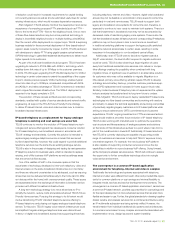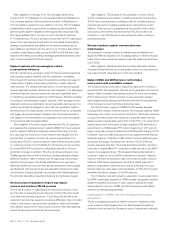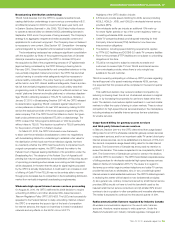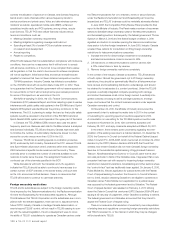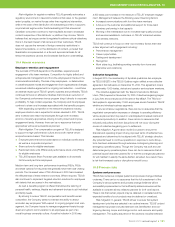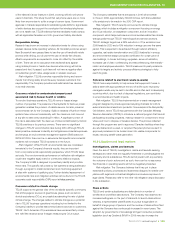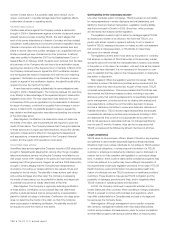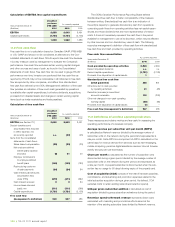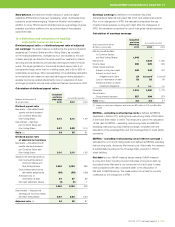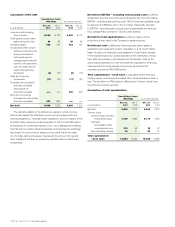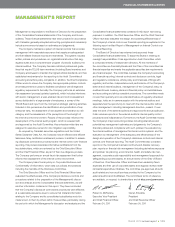Telus 2010 Annual Report Download - page 107
Download and view the complete annual report
Please find page 107 of the 2010 Telus annual report below. You can navigate through the pages in the report by either clicking on the pages listed below, or by using the keyword search tool below to find specific information within the annual report.
TELUS 2010 annual report . 103
MANAGEMENT’S DISCUSSION & ANALYSIS: 10
A reduction in TELUS credit ratings could impact
the Company’s cost of capital and access to capital
The Company’s cost of capital could increase and access to capital
might be affected by a reduction in the credit ratings of TELUS and/or
TCI. There can be no assurance that TELUS can maintain or improve
current credit ratings.
Risk mitigation: TELUS seeks to maintain debt credit ratings in
the range of BBB+ to A–, or equivalent. The four credit rating agencies
that rate TELUS currently have ratings that are in line with this target
with a stable outlook or trend and have confirmed TELUS’ ratings for
2010. TELUS has financial policies in place that were established to
help maintain or improve existing credit ratings. (See Section 7.4 Liquidity
and capital resource measures.)
Lower than expected free cash flow could constrain ability
to invest in operations or reduce debt
TELUS expects to generate free cash flow in 2011 after investing
approximately $1.7 billion of capital expenditures. Free cash flow would
be available to, among other things, pay dividends to the Company’s
shareholders. While anticipated cash flow is expected to be more than
sufficient to meet current requirements and remain in compliance with
TELUS’ financial policies, these intentions could constrain TELUS’ ability
to invest in its operations for future growth. As described in Section 1.5,
payment of net cash income taxes and funding of defined benefit pension
plans in the future will reduce the after-tax cash flow otherwise available
to return capital to the Company’s shareholders. If actual results are
different from TELUS’ expectations, there can be no assurance that
TELUS will not need to change its financing plans, including its intention
to pay dividends according to the target payout guideline.
Risk mitigation: The TELUS Board reviews the dividend each quarter,
based on a number of factors including a target dividend payout ratio
guideline of 55 to 65% of sustainable net earnings on a prospective
basis. This review resulted in TELUS announcing two quarterly dividend
increases in 2010, with the fourth quarter declaration at $0.525 per
share for dividends paid in January 2011. Based on the beginning-of-year
level of quarterly dividend and shares outstanding, annualized dividend
payments would total approximately $675 million in 2011. The Company
announced a return to the purchase of shares in the open market
for reinvested dividends rather than issue shares from treasury. In the
future, TELUS could seek Board approval to return to issuing shares
from treasury for reinvested dividends, in order to reduce cash outflows
in respect of dividends.
The Company’s financial instruments, and the nature of credit risks,
liquidity risks and market risks that they may be subject to, are described
in Financial instruments in Section 7.8.
10.7 Tax matters
Income and commodity tax amounts, including tax expense,
may be materially different than expected
The operations of TELUS are complex and related tax interpretations,
regulations and legislation that pertain to TELUS’ activities are subject to
continual change. The Company collects and pays significant amounts
of commodity taxes, such as provincial sales taxes, harmonized sales
taxes and federal goods and services taxes, to various taxation authorities.
The Company also accrues and pays significant amounts of income
taxes and has significant future income tax liabilities and income tax
expense. Income tax amounts are based on TELUS management’s esti-
mates, using accounting principles that recognize the benefit of income
Another core component of the TELUS strategy is payment card
industry (PCI) compliance, a rigorous set of standards leveraging the latest
security technology, such as encryption, to ensure the protection of cus-
tomer credit card information. These capabilities are being introduced
and implemented by TELUS and TELUS International in accordance with
the ongoing PCI certification program.
10.6 Financing and debt requirements
TELUS’ business plans and growth could be negatively
affected if existing
financing is not sufficient to cover
funding requirements
Risk factors such as disruptions in the capital markets, increased bank
capitalization regulations, reduced lending in general, or a reduced
number of active Canadian chartered banks as a result of reduced activity
or consolidation, could reduce capital available or increase the cost
of such capital for investment grade corporate issuers such as TELUS.
Risk mitigation: TELUS may finance future capital requirements
with internally generated funds, borrowings under the unutilized portion
of its bank credit facility, use of securitized accounts receivable, use of
commercial paper or the issuance of debt or equity securities. TELUS
has a shelf prospectus available until October 2011, under which,
as at December 31, 2010, it can offer up to $2 billion of debt and equity.
TELUS believes its adherence to its stated financial policies and the
resulting investment grade credit ratings, coupled with its efforts to main-
tain a constructive relationship with banks, investors and credit rating
agencies, continue to provide reasonable access to capital markets.
The Company has a $2 billion credit facility ($1.78 billion available at
December 31, 2010) that expires on May 1, 2012. This facility allows
the Company to continue to meet one of its financial objectives, which
is to generally maintain $1 billion in available liquidity. As described in
Section 7.6 Accounts receivable sale, TELUS Communications Inc. also
has an agreement with an arm’s-length securitization trust under which
it is able to sell an interest in certain of its trade receivables up to
a maximum of $500 million. At December 31, 2010, TCI had received
aggregate cash proceeds of $400 million, with $100 million available.
TCI is required to maintain at least a BBB (low) credit rating by DBRS Ltd.,
failing which, the Company may be required to wind down the program
prior to the May 2012 termination date of the agreement.
Ability to refinance maturing debt
At December 31, 2010, the only significant maturity of long-term debt in
2011 is the remaining U.S.$741 million of 8% Notes due June 1. TELUS
also operates a commercial paper program (maximum of $1.2 billion) that
permits access to low-cost funding. At December 31, 2010, TELUS had
$104 million of commercial paper issued, which must be refinanced on
an ongoing basis to enable the cost savings relative to borrowing on the
2012 credit facility to be realized. Capital market conditions may prohibit
the rolling of commercial paper at low rates.
Risk mitigation: Through successful financing activities in 2010
(see Section 7.3), TELUS increased the average term to maturity of its
long-term debt to 5.7 years at December 31, 2010, from 5.0 years at
December 31, 2009. The Company’s commercial paper program is fully
backstopped by the 2012 credit facility. In 2011, TELUS may issue addi-
tional long-term debt to help refinance the maturing 8% Notes, although
the Company has sufficient unutilized credit facilities to refinance this
debt without accessing the long-term debt markets. At December 31,
2010, TELUS’ long-term debt was $6.06 billion, with various amounts
maturing from 2011 to 2025 (see Section 4.3 for a debt maturity profile).




